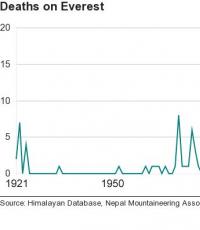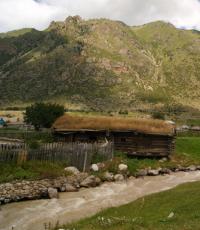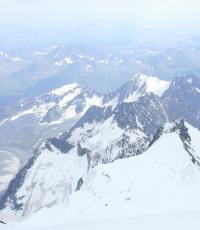Where does quicksand come from. Quicksand: what kind of natural phenomenon? What to do if you get caught in quicksand
// 0 Comments
Quicksand is a deadly attraction. The main danger lies in the fact that they are almost impossible to distinguish from ordinary sandy areas. This means that if you are traveling, for example, in the desert, where there is often the same type of landscape without stones and vegetation, then there is a chance at some point just start to fall "under the ground".
Quicksand: what is it
Basically, quicksands are formed in places where underground sources appear or when groundwater approaches the soil. In addition, the condition for their appearance is the presence of sand without clay impurities with a grain diameter of up to 3 mm.
The smallest particles of moisture, mixing with such sand, do not allow air to pass through, and the friction between the grains of sand disappears. As a result, the grains of sand turn into a semi-liquid mass, a swamp, which outwardly is almost impossible to distinguish from an ordinary desert or beach. It is a viscous mass with a huge reaction force.

How to spot quicksand
Visually detecting classic quicksand is difficult - they can lie in wait for a traveler anywhere along the entire path. There is a road that takes more than one day, gradually mindfulness becomes dull, which leads to serious consequences.
Since quicksand is a viscous quagmire, outwardly it looks like a flat surface with small motionless ripples. That is, any flat territory can potentially turn out to be an impassable swamp. It should be noted that sand can dry out on the surface of the bog and sometimes even grass grows on it.
Most often, quicksand can be found along the banks of reservoirs and in the lowlands of hills - where underground sources are likely to come to the surface. To make sure, you need to move slowly, be able to quickly get rid of the backpack and other cargo, as well as feel the road in front of you with a pole or stick.

In a normal, dry state, when pouring from vessel to vessel (let's take an hourglass as an example), sand passes air. But if there is moisture between the grains of sand, the air does not pass, and the sand does not spill out, clogging the passage. This property is the basis for the appearance of a quagmire.
Such a sandy is characterized by a huge counterforce. If a person's leg falls into quicksand, it is necessary to expend the effort of a heavyweight weightlifter to free it, and then, provided that his second leg has a reliable fulcrum and is on a solid surface.
In addition, the impact of a quagmire can be compared to a seat belt - the faster the trapped person moves, the stronger the swamp binds him. This is due to the momentary "solidification" of quicksand due to the appearance of rarefied air under the released foot. The presence of a discharged space leads to the opposite effect - tightening the leg even deeper ("collapse").
Quicksand vs. Man
At its core, quicksand can be attributed to a variety of non-Newtonian fluids with a high content of fine solids (grains of sand). That is why a person, getting into such a place, begins to fall into it, like into water. If at the same time he does not make sudden movements, then the dive will stop when the mass of the displaced sand becomes equal to the mass of a person.
What to do if you get caught in quicksand
There are certain rules of conduct when entering quicksand. Following these rules will allow you to get out of the situation alive.
1. Don't panic! If you start to twitch or make other sudden movements, you will go towards the core of the planet.
2. Fall on your back, flat, preferably on your back - in general, take a horizontal position with your whole body.
3. Try to immediately throw off everything superfluous - a backpack, a tent, etc. Life is more important.
If you start making sudden movements, pits will appear that will continue to suck. After the excitement has calmed down, move slowly, preferably back, in the direction from which you came, since it is not known how far the dangerous sands extend.
Relax your body, imagine that you are lying on your back in the water and relaxing. When moving, the sand should flow gently under the body and on the sides. This process is laborious, but effective. If your lower body does enter the sand vertically, place your torso on the surface and slowly but firmly release your legs.
Interesting and tragic facts about quicksand
Morecambe Bay, England. Known since the 15th century, when it was forbidden to enter the sand at high tide. Annually claimed the lives of up to 150 people. People who fell into quicksand died during a 9-meter high tide that covered them with their heads.
Goodwin Shoals at South Foreland, England. Devour the ships, the remains of which rise above the sands. The place is known as the "Ship Graveyard". One day, the Goodwin Shoals swallowed up the lighthouse tower.
Tarnagen Fjord, Alaska. The coast is about 80 km long and consists of quicksand.
Sable Island, Atlantic. Quicksand swallows entire ships after shipwrecks.
Jamaica, city of Port Royal. Completely drowned in quicksand in 1692. 2000 citizens died. After the earthquake, the soil hardened, so it was initially believed that the city was swallowed up by the “abyss of the sea”.
An example of hitting the quicksand of American paratroopers
This insidious natural trap awaits us at the most pleasant moment of life - during the long-awaited walk along the beach. Just when we are so relaxed and nothing portends trouble. The Freewanderer's Lair wishes you an unforgettable vacation and wants to warn you about this danger that could cost you your life.
Quicksand is a very dangerous phenomenon, and you can get into them completely unexpectedly. There are beaches all over the world that turn into a risk zone at high tide. In the summer, you want to walk on the yellow sand, and all of a sudden it begins to sink in and grab your feet. And you have no way to get out. Panic begins!
How and where do they appear
The condition for the formation of quicksand is a large source of water, located at a depth of one to ten meters. Such sources provoke shedding of sand. In most cases, they try to break out with great force, rising as close to the surface as possible and enveloping individual grains of sand with water.
Here's what it looks like schematically:
On the surface, a loose sandy mass impregnated with water is formed, which for some time retains its balance. But when any object hits it, the entire structure collapses, and physical forces try to return the displaced sand back. That is why suction occurs.
How to Identify Quicksand
It is sometimes impossible to determine the location of such sand. From above, it looks quite reliable, and there is no doubt whether it is possible to move on such a surface.
What to do to avoid getting into quicksand
- Take a stick with you!
When you go for a walk along the beach, take a large stick with you so that you can check the ground for quicksand.
Rules of conduct in quicksand
- Throw away everything you carried in your hands!
If you find yourself in quicksand, then try to throw away everything that was in your hands, such as a backpack.
Important: When going on such a walk, always wear light shoes, because, for example, boots will only increase the suction.
- Do not panic!
Try not to panic or make sudden movements. All active attempts to pull out, for example, a leg will form a rarefaction of air. A huge force will arise, which will drag the foot into the sand even more. Your ability to relax at this moment will depend on your life.
Surprising fact: The effort it takes to lift a foot out of quicksand can be compared to the weight of a car.
- Breathe deeply!
Deep breathing will help you stay calm and make you more buoyant.
- Lie on your back!
If you have sunk to the hip or higher, then bend back. The more you distribute your weight, the harder it will be to sink. Try to slowly and carefully release your legs. In this position, you can try to sort of swim on the sand. In this way, you can maintain balance for a certain time and wait for the arrival of rescuers who know everything about this phenomenon and actively monitor the shore in order to come to the rescue in time.
In this video you can see how to get out of the quicksand and bog:
quicksand
Quicksand, found in different parts of the globe, has always caused fear in people. It is generally accepted that this sand, which looks no different from the usual one nearby, is fraught with a mortal danger for anyone who steps on it. There are many stories about how these sands sucked their victims in until there was no trace of them. However, in reality, quicksand does not have such power. If you have an idea of \u200b\u200bwhat it is and how to behave correctly, then quicksand will not bring any harm.
Usually quicksands, or quicksands, appear near the mouths of large rivers and on gently sloping banks. These sands are formed due to the fact that under them there is a dense layer of clay that does not let moisture into the ground. This leads to the accumulation of rain and river water in the sand. The accumulating water dilutes the round grains of quicksand, and they seem to float in it. That is why they are not able to hold heavy objects on the surface.
Contrary to popular belief, people who get on quicksand do not drown in it at all. Since quicksand contains a lot of moisture, you can swim in them like in water. It is also important that quicksand is denser than water, and therefore it is easier to stay on the surface in it.
If you ever find yourself on quicksand, then remember to move slowly enough. This allows the sand to flow around your body, as it does when you swim in water. In this case, you can not be afraid for your life.
From the book Great Soviet Encyclopedia (PS) of the author TSB From the book Great Soviet Encyclopedia (RY) of the author TSB From the book Bulgaria. Guide by Shetar Daniela*Golden Sands A gently curved strip of golden sand, 4 km long and in some places more than 100 m wide, gave the name to the resort *Golden Sands (Zlatni Piasci) (10). The coast here is almost flat and forms a vast shallow water, and the sea is usually calm and completely devoid of currents, which
From the book 100 great records of the elements authorSinging Sands (According to V. Mezentsev) Dzhebel-Nakug (Bell Mountain) on the Red Sea has long been covered with legends. When a person climbs to its top, the sand seems to groan underfoot. In the depths of this mountain, the inhabitants of the Sinai Peninsula believe, is hidden
From the book The Newest Book of Facts. Volume 3 [Physics, chemistry and technology. History and archeology. Miscellanea] authorThe most treacherous quicksand Alaska has a 60-kilometer-long fjord made up of quicksand. On different continents, there are sea beaches, which at high tide turn into a slushy mess that sucks everything in a row. Stripes of sandy beaches along the coast
From the book All About Everything. Volume 3 the author Likum Arkady From the book 3333 tricky questions and answers author Kondrashov Anatoly PavlovichWhat is quicksand? In many places around the globe, people have lived in fear of quicksand for centuries. They were credited with the mysterious ability to suck in the victim until there was not a trace of it left on the surface of the earth. In fact, quicksand has no
From the book The Complete Encyclopedia of Our Delusions authorWhat is quicksand and why is it dangerous? There are many cases when people became victims of the so-called quicksand. It is easy to see something mystical in the ability of ordinary-looking sand to suddenly swallow objects on its surface,
From the book The Complete Illustrated Encyclopedia of Our Delusions [with illustrations] author Mazurkevich Sergey Alexandrovich From The Complete Illustrated Encyclopedia of Our Delusions [with transparent pictures] author Mazurkevich Sergey AlexandrovichQuicksand Quicksand, found in different parts of the world, has always caused fear in people. It is generally accepted that this sand, which looks no different from the usual one nearby, is fraught with a mortal danger for anyone who steps on it.
From the book 100 famous mysteries of nature author Syadro Vladimir VladimirovichQuicksand Quicksand, found in different parts of the world, has always caused fear in people. It is generally accepted that this sand, which looks no different from the usual one nearby, is fraught with a mortal danger for anyone who steps on it.
From the book 100 Great Records of the Elements [with illustrations] author Nepomniachtchi Nikolai Nikolaevich From the book Historical districts of St. Petersburg from A to Z author Glezerov Sergey EvgenievichThe most insidious quicksand In Alaska there is a fjord 60 kilometers long, consisting of quicksand. On different continents, there are sea beaches, which at high tide turn into a muddy mess that sucks everything in a row. Stripes of sandy beaches along the coast
From the book Who's Who in the Natural World author Sitnikov Vitaly PavlovichSands This was the name of the area occupied by the current Soviet (formerly Rozhdestvensky) streets, as well as Mytninskaya and Degtyarnaya streets crossing them, Suvorovsky, Grechesky and Ligovsky avenues. It was the highest part of the city that never
From the book What to do in emergency situations author Sitnikov Vitaly PavlovichWhat is quicksand? The infamous quicksand is sand with very fine grains of sand that contains large amounts of water. Heavy objects here very easily disappear from the surface, as if they are sucked in by sand. Unlike ordinary quicksand
From the author's bookSwamps and quicksand Precautions: Find a long pole to feel the way ahead. Choose higher places overgrown with shrubs. Step on those bumps on which heather grows. Move as slowly as possible
Walking somewhere in nature, enjoying the charm of flowering plants, listening to birds whistling cheerful songs, you can accidentally be trapped in quicksand. But you should immediately warn that everything is not so scary, as shown in some films of the "horror" genre. Yes, of course, it is better to avoid them, but at the same time, you should not be afraid. There are several consistent rules, the knowledge of which will help to avoid such situations.
What exactly is quicksand? It's really interesting, but not at all peculiar. A mixture of fine-grained material, clay and water (in desert places - a mixture of sand and air). It looks solid, but becomes unstable when pressure is applied to its surface. It is formed when water oversaturates such soil. Ordinary, naturally occurring sand (quarry, mountain, sea) consists of densely packed grains that form a rigid mass (approximately 25 to 30 percent of the space between the grains is filled with water or air). Since many grains of sand are elongated, they can separate, and then the voids will be from 30 to 70 percent of the mass. This mechanism is similar to a house of cards when the space between the cards is significantly larger than the space they occupy. The liquid contributes to the creation of liquefied soil, which is not able to withstand the weight load.

Quicksand can form in stagnant and flowing upward water (as in artesian springs). Water jets directed upwards resist and inhibit soil particles. Saturated precipitation may look quite solid, but a little on its surface initiates liquefaction. This causes the sand to form into a slurry and lose strength. Cushioned water produces quicksand, liquefied sediments, and a spongy, liquid-like soil texture. Objects entering such an environment sink to a level at which their weight is equal to the weight of the displaced mixture (from soil and water). Liquefaction is a special case of the phenomenon under consideration. So, in the event of an earthquake, the pore pressure instantly increases in shallow areas. Wet liquefied soil loses its strength, which leads to the collapse of buildings and other objects located on its surface.

Quicksand forms where natural springs exist, in marshy or wet places, near rivers, on beaches, although they are often not so easy to identify. If you suddenly get into them, they retreat quickly and gently, reacting with an interval of a couple of seconds. They are, that is, at rest they are a solid substance (gel-like form), but the slightest impact on them causes a sharp decrease in viscosity. In deserts, they are also found, but extremely rarely, where placers of sand appear, for example, on dunes. But the decline is limited to a few centimeters, because as soon as the air in the voids between the sand grains is removed (and this happens quickly), they re-compact.
You were walking in the desert, thinking, and suddenly found yourself in quicksand, quickly sinking to the bottom. Certain death in the mud? Not really. Quicksand is not even close to being as dangerous as it looks in the movies, although it is quite real. Any sand or silt can temporarily become quick-moving if sufficiently saturated with water and/or subject to vibrations such as during an earthquake. Here's what to do if you're going under.
Steps
Part 1
Freeing the legs- If you can get out of your shoes, do it. Shoes, especially those with flat, rigid soles (such as many types of boots), create a vacuum when you try to pull them out of the quicksand. If you know in advance that there is a high chance of getting into quicksand, take off your shoes and walk either barefoot or in shoes that can be easily removed.
-
Move in a horizontal direction. If you feel stuck, take a couple of quick steps back before the quicksand immobilizes you. It usually takes a few minutes for the mixture to become runny, so the best way to get out is not to get stuck in the sand at all.
- If your feet are still stuck, do not take large and abrupt steps in an attempt to free yourself. By taking a big step forward, you will be able to release one foot, but your other foot will sink even deeper, and full release will become extremely difficult.
-
Lie on your back. If your legs are sinking very quickly, sit down and lean back. Increasing the contact area should help you free your legs by eliminating the pressure they create and keeping them afloat. When you feel your legs begin to release, roll away from the sands and free yourself from their grip. You will be up to your neck in the mud, but this is the fastest and safest way to get out.
Do not hurry. If you're stuck in quicksand, panicking will only hurt your efforts to get out. Whatever you do, do it slowly. Slow motions prevent agitation of quicksand: Vibrations caused by fast motions can turn relatively hard ground into an extra mass of quicksand.
- More importantly, quicksand can react to your movements in completely unpredictable ways. If you move slowly, it will be easier for you to stop the adverse process and prevent further immersion. You will need to be patient. Depending on how much quicksand is around you, it can take anywhere from a few minutes to a few hours to slowly and methodically expel it.
Part 2
Climbing out of the deep quicksand-
Relax. Quicksand is never deeper than a meter, but if you hit a particularly deep section, you can sink into the sand up to your waist or up to your chest pretty quickly. Panicked, you can sink even deeper, but if you relax, the buoyancy of your body will not let you drown.
- Breathe deeply. Deep breathing will not only help you stay calm, it will also increase your buoyancy. Fill your lungs with as much air as possible. It is impossible to "go to the bottom" if your lungs are full of air.
-
Lie on your back and swim. If you are hip-deep or higher, lean back. The more you distribute your weight over the surface, the harder it will be for you to sink. Swim on your back, slowly and carefully releasing your legs. As soon as you release them, you can begin to carefully move towards the safe area, moving slowly and smoothly back with arm strokes, as if you were swimming. When you get to the edge of quicksand, you can roll onto solid ground.
Use a cane. When in an area with quicksand, walk with a cane. Feeling your ankles begin to sink, place the pole on the surface of the quicksand horizontally behind you. Lie on your back on a pole. After a couple of minutes, you will reach balance on quicksand and stop sinking. Push the pole towards the new position; move it under your hips. The pole will prevent the hips from sinking, so you can slowly release one leg first and then the other.
- Stay on your back with your arms and legs touching the quicksand and use the pole to probe. Move slowly on both sides along the pole until you reach solid ground.
-
Take more breaks. Getting out of quicksand, you can get tired from work.
Drop everything. If you step on with a backpack on or with something heavy in your hands, immediately remove your backpack or drop everything you are carrying. Because your body is less dense than quicksand, you won't drown completely unless you panic and try to climb out too violently, or unless you're overburdened with something heavy.




